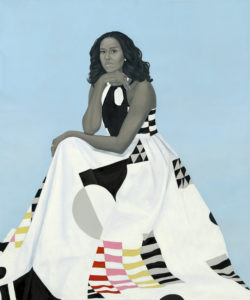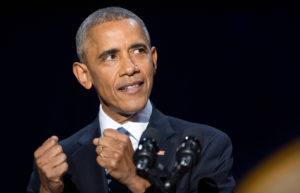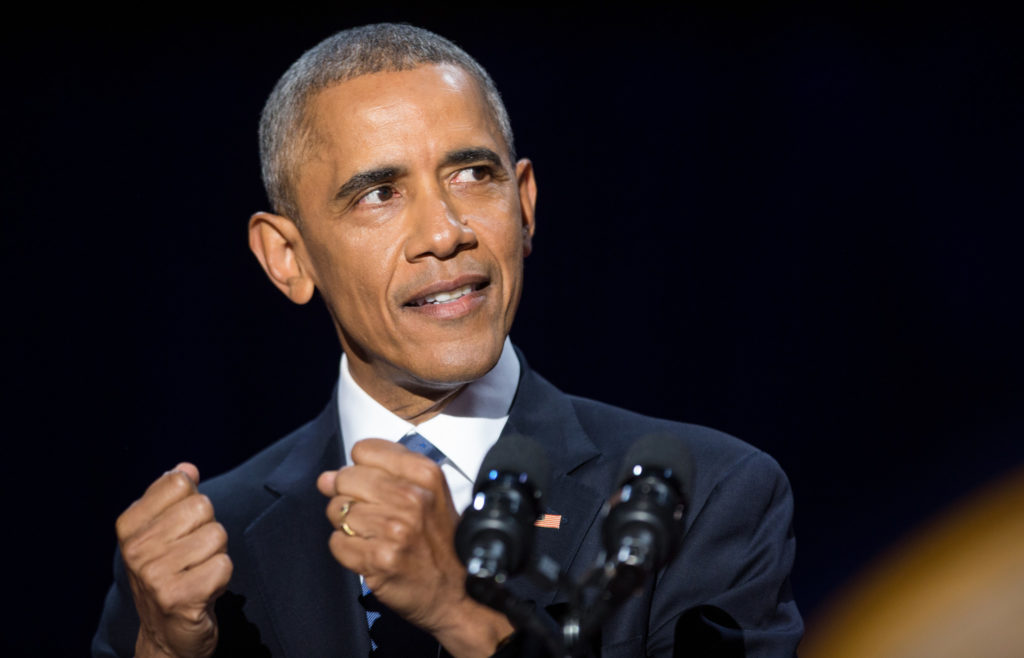Obama Portraits Intrigue and Challenge in Houston — This MFAH Moment is a Sensation For a Reason
When Iconic Figures and Groundbreaking Artists Come Together
BY Leslie Loddeke // 04.27.22Barack Obama, 2018, by Kehinde Wiley, oil on canvas, National Portrait Gallery, Smithsonian Institution. @2018 Kehinde Wiley. (Photo courtesy of Museum of Fine Arts, Houston)
Art and history lovers alike are heading to the Museum of Fine Arts, Houston, to take advantage of a special window of opportunity to visit with former President Barack Obama and First Lady Michelle Obama — as uniquely portrayed by two contemporary artists.
The MFAH is among only a handful of museums selected to host the Smithsonian Institution’s National Portrait Gallery tour of innovative artists Kehinde Wiley and Amy Sherald’s portraits. Presented in a suitably expansive space in the Law Building’s Cullinan Hall, the MFAH exhibition, which opened in early April, will close at the end of May.
These intriguing paintings have had broad appeal since they debuted in early 2018 at the National Portrait Gallery, which commissioned them. During just the first two years there, an estimated 4 million people visited the gallery to see the two artworks, essentially doubling the museum’s attendance since they were unveiled, National Portrait Gallery director Kim Sajet disclosed in a March 2020 CNN article. The following year, the portraits went on tour to select cities throughout the country.
Ever since, the portraits have continued to capture the imagination of viewers from all backgrounds, who have all brought their own interpretations to the symbolism and style of both works, and their own explanations for the portraits’ “unprecedented popularity,” in Sajet’s words.
Two major, undeniable reasons for the exhibition’s attraction to the public are cited by MFAH director and Margaret Alkek Williams chair Gary Tinterow: “Not only do these iconic portraits feature history-making subjects, but they were created by groundbreaking artists.”
Wiley and Sherald are the first African-American artists to have been selected for the National Portrait Gallery’s official portraits of a President or First Lady. Their paintings were unveiled Feb. 12, 2018 in the presence of the Obamas and the artists. Working closely with the Obamas, each of the artists took a novel view of how to present their subjects. Their efforts culminated in a dramatic departure from the traditionally formal style of official portraits of those who previously occupied those exalted posts.
Approaching the two massive paintings, the observer’s eye is inevitably drawn to the startling, unconventional background of bright-green, leafy foliage surrounding President Obama, who sits forward on a Federal Revival-style chair, his gaze intently directed at the viewer.
Against this living green wall, Wiley embedded flowers symbolizing milestones in the president’s life. Jasmine for his birthplace of Hawaii. Purple African lilies native to Kenya, his father’s birthplace. And chrysanthemums, the official flower of Chicago, where the young Obama worked as a community organizer.
All that unaccustomed foliage in a presidential portrait naturally attracted keen attention from Washington Post gardening columnist Adrian Higgins shortly after the portraits were unveiled in the National Portrait Gallery. He noticed he was far from the only one to be so mesmerized. Higgins reported that the crowds lining up to see Wiley’s portrait of Obama in the gallery were “gripped by a strange and compelling element,” — the backdrop of vegetation.
As Higgins was similarly gripped by this horticultural phenomenon, he sought to parse it out for the benefit of future presidential portrait viewers, opening with complimentary words for the greenery’s salubrious effect.
“Whatever the symbolism, there is something magical about a wall of lush vegetation – whether unexpected on a canvas or cosseting in a garden,” Higgins eloquently wrote. “A vertical, living tapestry has the power to clear the mind, lower the blood pressure and transport you to a place of delight.”
However, Higgins noted that achieving that ideal is a lot harder than it may appear, particularly in terms of maintaining the outdoors version. Based on his descriptions, this caveat would seem to apply whether a gardener uses the traditional method of planting vines in the ground and letting them climb up a wall, or tries a more recent method to create a type of vegetation known as living walls or green walls, which rely on pockets to hold the roots. Which sounds extremely time- and labor-intensive.
Higgins cited a particularly remarkable green wall known as “l’Oasis d’Aboukir,” created by French designer Patrick Blanc, which transforms the side of a five-story building in Paris into a veritable jungle of thick vegetation. Closer to home, he pointed out the Green Wall at Longwood Gardens in Kennett Square, Pennsylvania., which encompasses 33,000 thirsty plants requiring constant care by a gardener and four volunteers. Commercial applications are also emerging, he noted.
Within the official presidential portrait, the specter of a big, leafy wall of greenery may well strike the average viewer as strange in context, but the subject is immediately recognizable. The familiar face of Barack Obama, who is dressed in a dark suit but no tie, looks directly at the viewer with a serious expression, making a no-nonsense, eye-to-eye connection. His hands are prominently displayed, folded in his lap. He looks a little edgy, as if waiting for a friendly opponent to make a pivotal move in a good game of chess, at which point he’ll probably pounce.
The New York Times’ Holland Cotter opined that Obama’s “engaged and assertive” demeanor in his portrait contradicts the impression Cotter says he often made in office of being “philosophically detached” from what was going on around him.
One wonders what the artist was thinking as he painted Obama wearing this expression, striking what seems to be an all-business pose in a garden-like setting.
In a revealing video interview with Times reporter Robin Pogrebin, Wiley explained that he was dealing not only with the idea of power, but literal power in the presidential portrait. He wanted a sense of accessibility to come across, using a language of openness, projecting a sense of repose but at the same time, a “radical vigilance” that could be seen in the president’s eyes.
All told, this is an undeniably fresh, vibrant, bigger-than-life perspective of the former president in a style that lends itself to an intimate connection with observers, and is well worth seeing during the limited time the paintings are on view in Houston.
The First Lady
On a cooler note set by a sky-blue background, Amy Sherald depicted Michelle Obama in a pensive pose, resting her chin on her hand as she looks directly at the viewer, like her husband. The perennially elegant First Lady does fashion model-like justice to a beautiful cotton poplin dress by Milly designer Michelle Smith with references to abstract artist Piet Mondrian as well as the traditional patterned quilts crafted over many years by African-American women in Gee’s Bend, Alabama.

In the Pogrebin interview, Sherald explained that she wanted her portrait to represent the First Lady’s “quiet, strong presence.” She remarked that the former First Lady “gave a lot of us permission to be better, and to want to do better.”
The artist’s reference to Michelle Obama’s propensity to inspire evoked the memory of the often-quoted comment Michelle Obama made in advising a dignified response to cruelty: “When they go low, we go high.” For me, this association shed further light on the somber expression the First Lady wears, projecting a strong, centered presence in her official portrait. This picture offers much to contemplate, analyze and remember.
The tour is accompanied by the illustrated book, The Obama Portraits, co-published by the National Portrait Gallery and Princeton University Press.
The national tour of the two portraits, which have garnered international attention since they were unveiled in 2018, was organized by the National Portrait Gallery. “The Obama Portraits Tour” was initiated by popular demand from museums across the country and the National Portrait Gallery’s mission to broaden discussions on portraiture, according to the gallery’s website.
The tour opened to huge crowds on June 18, 2021, at the Art Institute of Chicago (the Obamas’ hometown), where it consistently broke daily attendance records, and went on to Brooklyn, Los Angeles, Atlanta and now, Houston. Earlier this year, the National Portrait Gallery announced that two more stops would be added: the DeYoung Museum in San Francisco (June 18 to August 14) and the Museum of Fine Arts, Boston (September 3 to October 30.)
The exhibition presented at the MFAH is included with general admission, but advanced timed tickets are recommended.















_md.jpg)








_md.jpg)













_md.jpg)


_md.jpg)












_md.jpg)






_md.jpg)
_md.jpg)





_md.jpg)






